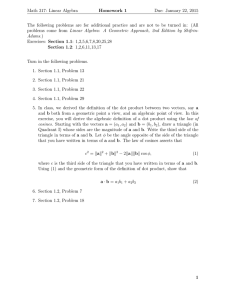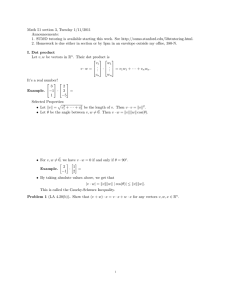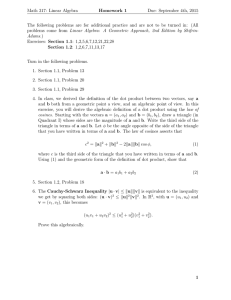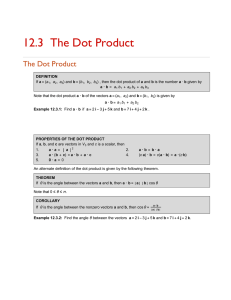Document 13694972
advertisement
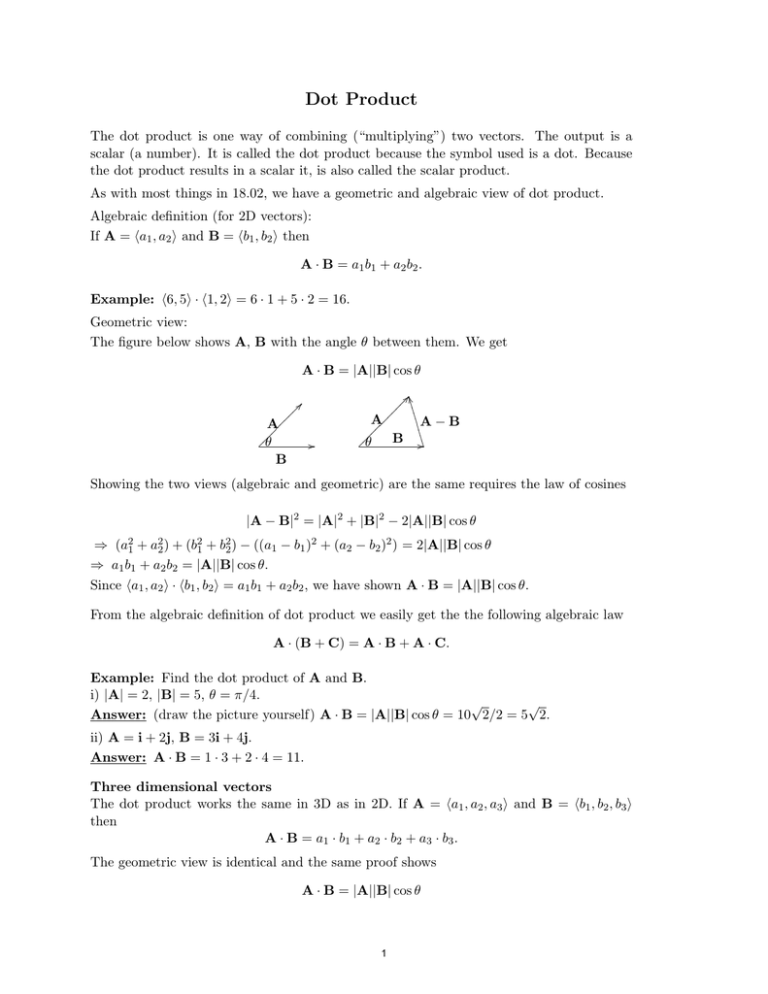
Dot Product The dot product is one way of combining (“multiplying”) two vectors. The output is a scalar (a number). It is called the dot product because the symbol used is a dot. Because the dot product results in a scalar it, is also called the scalar product. As with most things in 18.02, we have a geometric and algebraic view of dot product. Algebraic definition (for 2D vectors): If A = (a1 , a2 ) and B = (b1 , b2 ) then A · B = a1 b1 + a2 b2 . Example: (6, 5) · (1, 2) = 6 · 1 + 5 · 2 = 16. Geometric view: The figure below shows A, B with the angle θ between them. We get A · B = |A||B| cos θ L� LL L L A LL L LLθ L� LL L LL A A−B LL L L B LLθ B Showing the two views (algebraic and geometric) are the same requires the law of cosines |A − B|2 = |A|2 + |B|2 − 2|A||B| cos θ ⇒ (a21 + a22 ) + (b21 + b22 ) − ((a1 − b1 )2 + (a2 − b2 )2 ) = 2|A||B| cos θ ⇒ a1 b1 + a2 b2 = |A||B| cos θ. Since (a1 , a2 ) · (b1 , b2 ) = a1 b1 + a2 b2 , we have shown A · B = |A||B| cos θ. From the algebraic definition of dot product we easily get the the following algebraic law A · (B + C) = A · B + A · C. Example: Find the dot product of A and B. i) |A| = 2, |B| = 5, θ = π/4. √ √ Answer: (draw the picture yourself) A · B = |A||B| cos θ = 10 2/2 = 5 2. ii) A = i + 2j, B = 3i + 4j. Answer: A · B = 1 · 3 + 2 · 4 = 11. Three dimensional vectors The dot product works the same in 3D as in 2D. If A = (a1 , a2 , a3 ) and B = (b1 , b2 , b3 ) then A · B = a1 · b1 + a2 · b2 + a3 · b3 . The geometric view is identical and the same proof shows A · B = |A||B| cos θ 1 Example: Show A = (4, 3, 6), B = (−2, 0, 8), C = (1, 5, 0) are the vertices of a right triangle. −−→ −−→ Answer: Two legs of the triangle are AC = (−3, 2, −6) and AB = (−6, −3, 2) ⇒ −−→ −−→ AC · AB = 18 − 6 − 12 = 0. The geometric view of dot product implies the angle between the legs is π/2 (i.e cos θ = 0). •� B z� �� � �� �� � � �� � A• •C y x Definition of the term orthogonal and the test for orthogonality When two vectors are perpendicular to each other we say they are orthogonal. As seen in the example, since cos(π/2) = 0, the dot product gives a test for orthogonality between vectors: A ⊥ B ⇔ A · B = 0. Dot product and length Both the algebraic and geometric formulas for dot product show it is intimately connected to length. In fact, they show for a vector A A · A = |A|2 . Let’s show this using both views. Algebraically: suppose A = (a1 , a2 , a3 ) then A · A = (a1 , a2 , a3 ) · (a1 , a2 , a3 ) = a21 + a22 + a32 = |A|2 . Geometrically: the angle θ between A and itself is 0. Therefore, A · A = |A||A| cos θ = |A||A| = |A|2 . As promised both views give the formula. 2 MIT OpenCourseWare http://ocw.mit.edu 18.02SC Multivariable Calculus Fall 2010 For information about citing these materials or our Terms of Use, visit: http://ocw.mit.edu/terms.
